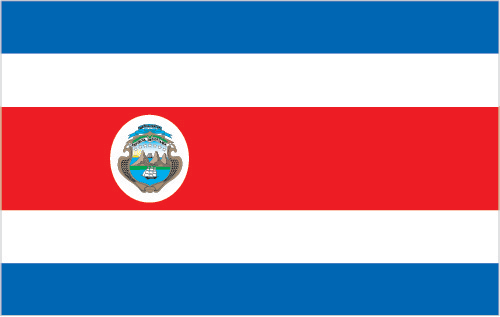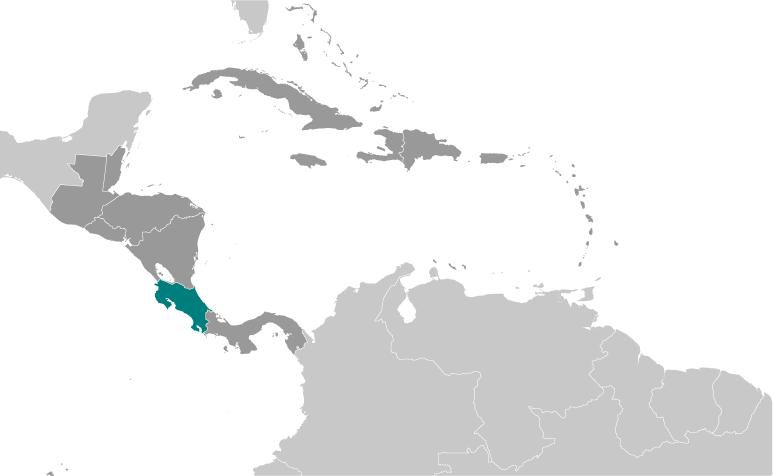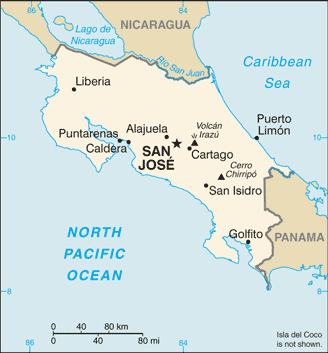|
Economy - overview:
|

|
|
Prior to the global economic crisis, Costa Rica enjoyed stable economic growth. The economy contracted 1.3% in 2009 but resumed growth at about 4.5% per year in 2010-12. While the traditional agricultural exports of bananas, coffee, sugar, and beef are still the backbone of commodity export trade, a variety of industrial and specialized agricultural products have broadened export trade in recent years. High value added goods and services, including microchips, have further bolstered exports. Tourism continues to bring in foreign exchange, as Costa Rica's impressive biodiversity makes it a key destination for ecotourism. Foreign investors remain attracted by the country's political stability and relatively high education levels, as well as the incentives offered in the free-trade zones; and Costa Rica has attracted one of the highest levels of foreign direct investment per capita in Latin America. However, many business impediments remain such as high levels of bureaucracy, legal uncertainty due to overlapping and at times conflicting responsibilities between agencies, difficulty of enforcing contracts, and weak investor protection. Poverty has remained around 20-25% for nearly 20 years, and the strong social safety net that had been put into place by the government has eroded due to increased financial constraints on government expenditures. Unlike the rest of Central America, Costa Rica is not highly dependent on remittances as they only represent about 2% of GDP. Immigration from Nicaragua has increasingly become a concern for the government. The estimated 300,000-500,000 Nicaraguans in Costa Rica legally and illegally are an important source of mostly unskilled labor but also place heavy demands on the social welfare system. The US-Central American-Dominican Republic Free Trade Agreement (CAFTA-DR) entered into force on 1 January 2009 after significant delays within the Costa Rican legislature. CAFTA-DR has increased foreign direct investment in key sectors of the economy, including the insurance and telecommunications sectors recently opened to private investors. President CHINCHILLA was not able to gain legislative approval for fiscal reform, her top priority, though she continued to pursue fiscal reform in 2012. President CHINCHILLA and the PLN were successful in passing a tax on corporations to fund an increase for security services.
|
|
|
GDP (purchasing power parity):
|

|
|
$58.6 billion (2012 est.)
country comparison to the world: 89
$55.92 billion (2011 est.)
$53.68 billion (2010 est.)
note:
data are in 2012 US dollars
|
|
|
GDP (official exchange rate):
|

|
|
$44.88 billion (2012 est.)
|
|
|
GDP - real growth rate:
|

|
|
4.8% (2012 est.)
country comparison to the world: 66
4.2% (2011 est.)
4.7% (2010 est.)
|
|
|
GDP - per capita (PPP):
|

|
|
$12,600 (2012 est.)
country comparison to the world: 103
$12,100 (2011 est.)
$11,800 (2010 est.)
note:
data are in 2012 US dollars
|
|
|
GDP - composition by sector:
|

|
|
agriculture: 6.2%
industry:
21.1%
services:
72.7% (2012 est.)
|
|
|
Labor force:
|

|
|
2.196 million
country comparison to the world: 119
note:
this official estimate excludes Nicaraguans living in Costa Rica (2012 est.)
|
|
|
Labor force - by occupation:
|

|
|
agriculture: 14%
industry:
22%
services:
64% (2006 est.)
|
|
|
Unemployment rate:
|

|
|
7.9% (2012 est.)
country comparison to the world: 89
6.5% (2011 est.)
|
|
|
Population below poverty line:
|

|
|
24.8% (2011 est.)
|
|
|
Household income or consumption by percentage share:
|

|
|
lowest 10%: 1.2%
highest 10%:
39.5% (2009 est.)
|
|
|
Distribution of family income - Gini index:
|

|
|
50.3 (2009)
country comparison to the world: 21
45.9 (1997)
|
|
|
Investment (gross fixed):
|

|
|
19.9% of GDP (2012 est.)
country comparison to the world: 98
|
|
|
Budget:
|

|
|
revenues: $6.949 billion
expenditures:
$8.937 billion (2012 est.)
|
|
|
Taxes and other revenues:
|

|
|
15.5% of GDP (2012 est.)
country comparison to the world: 185
|
|
|
Budget surplus (+) or deficit (-):
|

|
|
-4.4% of GDP (2012 est.)
country comparison to the world: 146
|
|
|
Public debt:
|

|
|
47.4% of GDP (2012 est.)
country comparison to the world: 72
44.9% of GDP (2011 est.)
|
|
|
Inflation rate (consumer prices):
|

|
|
4.5% (2012 est.)
country comparison to the world: 124
4.9% (2011 est.)
|
|
|
Central bank discount rate:
|

|
|
21.5% (31 December 2010 est.)
country comparison to the world: 5
23% (31 December 2009 est.)
|
|
|
Commercial bank prime lending rate:
|

|
|
16% (31 December 2012 est.)
country comparison to the world: 33
16.15% (31 December 2011 est.)
|
|
|
Stock of narrow money:
|

|
|
$4.209 billion (31 December 2012 est.)
country comparison to the world: 106
$3.693 billion (31 December 2011 est.)
|
|
|
Stock of broad money:
|

|
|
$20.09 billion (31 December 2011 est.)
country comparison to the world: 86
$18.68 billion (31 December 2010 est.)
|
|
|
Stock of domestic credit:
|

|
|
$23.33 billion (31 December 2012 est.)
country comparison to the world: 77
$19.21 billion (31 December 2011 est.)
|
|
|
Market value of publicly traded shares:
|

|
|
$1.443 billion (31 December 2011)
country comparison to the world: 101
$1.445 billion (31 December 2010)
$1.452 billion (31 December 2009)
|
|
|
Agriculture - products:
|

|
|
bananas, pineapples, coffee, melons, ornamental plants, sugar, corn, rice, beans, potatoes; beef, poultry, dairy; timber
|
|
|
Industries:
|

|
|
microprocessors, food processing, medical equipment, textiles and clothing, construction materials, fertilizer, plastic products
|
|
|
Industrial production growth rate:
|

|
|
2.8% (2011 est.)
country comparison to the world: 99
|
|
|
Current account balance:
|

|
|
-$2.556 billion (2012 est.)
country comparison to the world: 145
-$2.2 billion (2011 est.)
|
|
|
Exports:
|

|
|
$11.47 billion (2012 est.)
country comparison to the world: 89
$10.38 billion (2011 est.)
|
|
|
Exports - commodities:
|

|
|
bananas, pineapples, coffee, melons, ornamental plants, sugar; beef; seafood; electronic components, medical equipment
|
|
|
Exports - partners:
|

|
|
US 30.4%, China 11.3%, Netherlands 10.9%, UK 9.6%, Mexico 8.5% (2011)
|
|
|
Imports:
|

|
|
$16.79 billion (2012 est.)
country comparison to the world: 83
$15.53 billion (2011 est.)
|
|
|
Imports - commodities:
|

|
|
raw materials, consumer goods, capital equipment, petroleum, construction materials
|
|
|
Imports - partners:
|

|
|
US 43%, Mexico 7%, China 6.2%, Japan 6% (2011)
|
|
|
Reserves of foreign exchange and gold:
|

|
|
$5.461 billion (31 December 2012 est.)
country comparison to the world: 87
$4.756 billion (31 December 2011 est.)
|
|
|
Debt - external:
|

|
|
$12.04 billion (31 December 2012 est.)
country comparison to the world: 88
$10.75 billion (31 December 2011 est.)
|
|
|
Stock of direct foreign investment - at home:
|

|
|
$18.59 billion (31 December 2012 est.)
country comparison to the world: 70
$16.34 billion (31 December 2011 est.)
|
|
|
Stock of direct foreign investment - abroad:
|

|
|
$729.3 million (31 December 2012 est.)
country comparison to the world: 77
$704.3 million (31 December 2011 est.)
|
|
|
Exchange rates:
|

|
|
Costa Rican colones (CRC) per US dollar -
504.5 (2012 est.)
505.66 (2011 est.)
525.83 (2010 est.)
573.29 (2009)
530.41 (2008)
|
|
|
Fiscal year:
|

|
|
calendar year
|
|
|
|





 )
)



